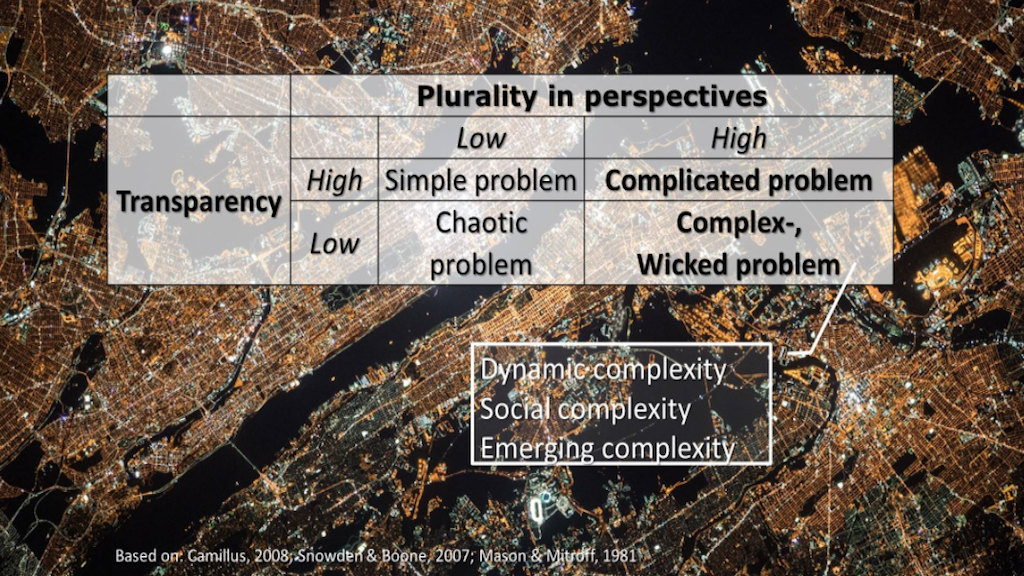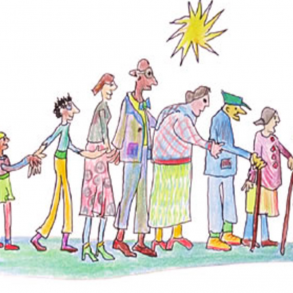Snippets from a conversation in the EE Community on Facebook
January 7, 2017
COMPLEXITY THEORY and THE MOVEMENT OF NEXT-STAGE ORGANIZATIONS
René Katerberg wrote:
“To show ‘orange’ how to be more successful (their thinking) they would have to adopt complexity theories and change their paradigm from looking at the world as a machine.”
They have been doing that for the last 22 years, since the Santa Fe Institute, a leading “complexity” think tank launched its Business Network for Complex Systems Research that helped leaders of large (Orange) organizations employ “complex systems” insights to better achieve their organization’s goals.
Now it’s time for the people and organizations exiting Orange and Green, end entering Teal, to embrace and embody complexity thinking and practices. Frederic‘s work is brilliant and trailblazing, but my hypothesis is that organizations are NOT going to reach the Teal altitude of development (characterized by the capacity to align systems with the natural design), unless they draw on the insights of work done on Complex Adaptive Systems (CAS).
Similarly, at the societal scale, the movement of organizations “going Teal” will NOT reach the tipping point, where they could become the new mainstream, unless they demonstrate their evolutionary advantage of using resources (including the creativity of the multitudes) better, more efficiently than the still dominant Orange paradigm.
For those who want to be in inquiry with me into that hypothesis, I’d recommend to read a little book of great wisdom: What IS Organizational Intelligence?, by Michael D. McMaster, one of the original members of Santa Fe Business Network, who has been my mentor in complexity matters since the 90’s. https://www.amazon.com/What-Organizational-Intelligence-Intense-Primer/dp/1537780972/
January 7, 2017
Thank you George Pór I do not yet know this book. To illustrate what is happening in the economics field I attach a link from Glocomnet. Our linear thinking in economics and supporting institutions will have to change as well. https://glocomnet.com/library/presentations-interviews-from-oecd-workshop-complexity-of-the-economy-oecd-paris
René, as you know there are many books, consultancies, conferences, and websites, addressing and transcending the limitations of linear thinking that worked in the industrial era, but is inadequate to deal with the complex challenges of organizations and societies in the 21st century.
While many big Orange organizations are borrowing tools from complexity sciences, in my experience “organizations going Teal” are lagging behind them in that regard. I guess that’s because exiting Green and early-stage Teal is still largely dominated by the human-centric worldview and has not yet matured to include and fully transcend it in a world-centric worldview.
For next-stage organizations to realize their full potential, they need to increase their flexibility, adaptability, and innovative capacity. Next-stage companies need to organize themselves as self-learning neural net or as the brain does.
As Robert Kegan suggested, we may well be “cognitively and emotionally mismatched” to respond to the mental demands of modern life. That seems to be also true for most organizations’ readiness to meet the challenge of galloping complexity multiplied by the urgency with which marketplace and society are expecting responses.
Therefore, the most challenging and most rewarding task of change leaders in next-stage organizations is to facilitate the emergence of a transformative, “complexity intelligence” that includes:
“(1) recognition that a gap exists between the life conditions currently facing us and our current operating beliefs and assumptions of how the world works (e.g. without a futures context many leaders are assuming they can do business as usual, not seeing that a shift in technology, transportation, health care, the economic base etc. will require completely different capacities for thinking and acting.)
(2) perseverance to stay engaged in the gap with the resulting confusion, contradiction, and frustration as we dis-embed from our familiar operating beliefs; and
(3) exposure and openness to a new conceptual framework that helps validate the recognition of this gap.”~ Complexity Intelligence and Cultural Coaching, by Jan Inglis and Margaret Steele
Jon Freeman
January 7
This seems to align strongly with so much that I write and I have ordered the Kindle version, though heaven knows when I will find the time to read it!
There is no question for me regarding our need to embrace complexity. The challenge (and I am interested in how the book approaches this) is to get beyond theory, and past any attempts to analyse the complexity in the search for answers. Analysis is a primary Blue/Orange tool.
George is pointing in a similar direction above. I regularly use the image of attempting to analyse the wave rather than being “in the moment” of surfing, responding dynamically to the shifts.
Kegan may well be right that we are not cognitively and emotionally matched to the demands of new life conditions. I am convinced though, that this is a result of how we are raised, educated, and trained, and how the benefits of modern science and technology-based existence have taken us too far. We value our cognitive and intellectual capacities so much that we have been systematically training out the sensing, embodying and deep pattern-recognition that would otherwise be available. We have also trained out intuition and connectedness—the capacities that shamanistic cultures incorporate into their living reality.
It is not that we don’t have the required capacities within us, from an evolutionary point of view. Rather, we have suppressed them and removed them from our cultural, collective reality, forcing humanity into a narrow bandwidth of experience and understanding. Our familiar operating beliefs are inadequate, and the confusion is rising because the world is filled with paradoxes that cannot be resolved and polarities that must be danced with, not chosen between.
I would suggest the need to distinguish between “complexity intelligence” and the integration of multiple intelligences. Some of those intelligences are deep down in our inheritance, and we cannot move up-spiral without also re-engaging downwards.
René Katerberg
January 7
I was made aware of this research through one of my professors at Maastricht University about dealing with wicked/complex problems. The approach is different from complicated problems (linear/machine thinking). Complicated=sense-analyse-respond, Complex=probe-sense-respond (Cynefin Framework). So you take a different approach to handling problems.
When you use this wearing your ‘orange’ hat you probably come to some sub-optimal solutions, not solving the real problem. I would put UBER in this category.
You probably first need the individual awareness/cognition, then see the value in the “complexity intelligence” and connect. Only then there are useful tools available then can help you. I’m thinking about the appropriate application of AI in the sensing part. The internet made these ‘competences’ available at lower cost than before and therefore supports the emergence of its use. Digital natives growing up with these technologies also fuel a higher adoption rate.
In addition you can then also see the value of skills learned from Scharmer, et al. For this to happen you need some critical mass and all the leadership skills to support, and lots of patience, during the transition period.
Mieke Byerley
January 7
Thank you for sharing this I am going to have to make some time to get through this and digest it. Love to all of you, George, Jon, Chris, Anna. By the way I hope you all had a beautiful Christmas season and New Years.
Victor Vorski
January 8
Well, if George recommends, it is a must read, just got it… 🙂
George Pór
January 8
Jon Freeman wrote
“We have also trained our intuition and connectedness—the capacities that shamanistic cultures incorporate into their living reality. It is not that we don’t have the required capacities within us, from an evolutionary point of view. Rather, we have suppressed them and removed them from our cultural, collective reality, forcing humanity into a narrow bandwidth of experience and understanding.”
That’s one way of looking at our conundrum. Another, complementary way would start with recognizing that our intuition and sense of connectedness can support but not replace our understanding of an organization’s systemic interdependence in the complex web of our Emerging Planetary Reality.
I would not reject off-hand Kegan’s assertion that we are “cognitively and emotionally mismatched” to respond to the mental demands of modern life. Taking a closer look at it, what I see that the brain cannot hold two thoughts, let alone two conflicting perspectives AT THE VERY SAME TIME. That’s one of the reasons for the emergence of “collective intelligence” research and practices in the last 50 years.
So when I’m talking about “complexity intelligence,” I mean not only the much needed integration of all or ways of knowing, but also, the (painful?) dropping of the idea that the individual is the most important unit of cognition and recognizing that the collective is. It’s an epic move that parallels the recognition that ”the self as a unit of wholeness is too small,” as Chris Clark put it.
The implications of that realization for the strategies of “next-stage” organizing cannot be overestimated.
January 8
Beautifully said, George.
Anna Betz
March 3
ORGANIZATIONS ARE LIVING SYSTEMS
“It is time to change the way we think about organizations. Organizations are living systems. All living systems have the capacity to self-organize, to sustain themselves and move toward greater complexity and order as needed. They can respond intelligently to the need for change. They organize (and then reorganize) themselves into adaptive patterns and structures without any externally imposed plan or direction.
Self-organizing systems have what all leaders crave: the capacity to respond continuously to change. In these systems, change is the organizing force, not a problematic intrusion. Structures and solutions are temporary. Resources and people come together to create new initiatives, to respond to new regulations, to shift the organization’s processes. Leaders emerge from the needs of the moment. There are far fewer levels of management. Experimentation is the norm. Local solutions predominate but are kept local, not elevated to models for the whole organization. Involvement and participation constantly deepen.
These organizations are experts at the process of change. They understand their organization as a process of continuous organizing.”
Source: The Irresistible Future of Organizing, by Margaret J. Wheatley and Myron Kellner Rogers
Featured Image/graphic link added by Enlivening Edge Magazine




